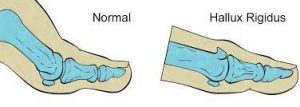Biggest isn’t always Best

By Jack Eastwood
This month we are looking at the big toe deformities and what effects they can cause to the foot. Examples of big toe deformities include Bunions and Hyperextension. Rheumatoid Arthritis and conditions eg. Gout can also cause problems in the big toe.
Bunions
A bunion is a bony lump (also known as hallux valgus) which is on the inside of the foot just below the big toe. This can occur due to genetics, footwear or possibly due to another condition such as Rheumatoid Arthritis.

As the big toe deviates and rotates towards the second toe the big toe joint starts to deform. The metatarsal starts to deviate medially and cause and angle to develop from metatarsal to toe. This, as you can imagine, will put the joint out of line and reduce its range of motion and ultimately its effective use.
This lump will then tend to rub on previously well-fitting footwear as it will start to make the foot appear wider than it used to be. This rubbing can start to cause a bursa which can be quite painful. In the summer open toed shoes will increase comfort and in the colder periods stretchable soft fabric shoes will help reduce the discomfort. Poor fitting footwear can cause bunions to get worse as they may be squeezing the toes together which will then exacerbate the angle between the metatarsal and toe.
Hallux Hyperextension
Hallux hyperextension is a condition where the big toe is constantly dorsiflexed (pointing up) which can cause abnormal amounts of pressure on the big toe as it will be hitting the top of the shoe. This is either fixed due to previous trauma/ other condition or can be flexible due to a tight extensor hallucis longus tendon. This can then cause a high area of pressure on the underneath of the first metatarsophalangeal joint and may lead to a build-up of hard skin or a corn which can become quite sore if left untreated.
Rheumatoid Arthritis
Rheumatoid Arthritis is an autoimmune condition which causes the body to attack itself, which can cause problems in the joints in the foot, especially in the big toe. Rheumatoid Arthritis causes the joint lining to swell which in turn changes the shape of the joint and reduces the range of motion. This can cause a small bony lump and like a bunion can cause the big toe to lean over onto the other toes. As well as also creating an area which is susceptible to rubbing when in close fitting footwear.
If there is Rheumatoid Arthritis in the big toe, then there may be compromises in the gait cycle. This is due to the big toe being the biggest leaver out of all of the toes, this means that there is a lot of pressure and weight going through the big toe and if that joint is compromised then there is potential for problems in the lesser toes.
If there is Rheumatoid Arthritis present and it is causing problems, then a steroid injection or possibly orthoses may be beneficial to keep the gait cycle working at its best.
Hallux rigidus

Hallux rigidus is a condition which means there is little or no movement in the big toe. This can be due many conditions such as a bunion or possibly Rheumatoid Arthritis and can also be very painful as previously stated the big toe is the biggest lever compared to the other toes. This means that reduction in the ability of this leaver can cause problems in the lesser toes and also around the joint. This reduction is because of a bony deformity which stops the toe being able to move on the joint.
Graphic Sources:
https://www.chelwest.nhs.uk/your-visit/patient-leaflets/surgery-services/bunion-management



